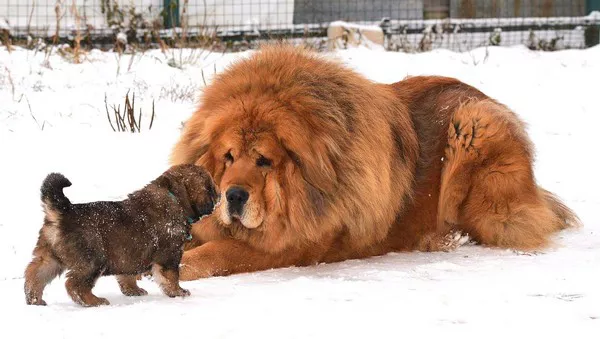Tibetan Mastiffs, with their majestic presence and unique dietary needs, require careful consideration when it comes to their nutrition. In this comprehensive guide, we delve into the essential aspects of feeding Tibetan Mastiffs, covering topics from caloric requirements and portion sizes to feeding schedules, hydration, and dietary considerations for puppies. Whether you’re a seasoned Tibetan Mastiff owner or welcoming a new puppy into your home, understanding the truth about their dietary needs is crucial for their overall well-being.
How Many Calories Should I Feed My Tibetan Mastiff?
Determining the appropriate caloric intake for your Tibetan Mastiff is a critical first step in their nutritional care. Factors such as age, weight, activity level, and overall health play a role in establishing the right calorie count. Consulting with your veterinarian can provide personalized guidance based on your specific dog‘s needs. Typically, adult Tibetan Mastiffs may require around 1,600 to 2,500 calories per day, but individual variations should be considered.
How Many Cups of Food Should a Tibetan Mastiff Eat?
Understanding portion sizes is key to maintaining your Tibetan Mastiff’s weight and overall health. While the exact amount can vary based on factors like the dog’s size and activity level, a general guideline suggests 4 to 6 cups of high-quality dog food per day for adult Tibetan Mastiffs. Splitting the daily portion into two meals helps regulate digestion and prevents overeating. Adjustments may be necessary based on your dog’s individual metabolism and lifestyle.
How Much Wet Food Should I Feed My Tibetan Mastiff?
Wet food can be a nutritious addition to your Tibetan Mastiff’s diet, providing moisture and flavor. The recommended amount of wet food can vary, but it is often suggested to complement rather than replace dry kibble. A common guideline is to mix about a quarter to half a can of wet food with your dog’s dry food, adjusting based on individual preferences and dietary requirements. Always check with your veterinarian to ensure the chosen wet food meets your Tibetan Mastiff’s nutritional needs.
How Many Times a Day Does a Tibetan Mastiff Need to Eat?
Establishing a feeding schedule aligns with the natural behavior of Tibetan Mastiffs. Adult dogs typically benefit from being fed twice a day—once in the morning and once in the evening. This schedule helps maintain stable energy levels and supports a consistent digestive routine. Puppies, with their higher energy demands, may require more frequent meals, often three to four times a day. Adhering to a regular feeding schedule promotes a healthy metabolism and aids in weight management.
When Should I Feed My Tibetan Mastiff?
Timing is crucial in ensuring optimal digestion and preventing issues like bloat. Aim to feed your Tibetan Mastiff at consistent times each day, avoiding strenuous exercise immediately before or after meals. Feeding before exercise can lead to discomfort and increase the risk of bloat, a condition common in deep-chested breeds like Tibetan Mastiffs. Establishing a routine and adhering to it helps regulate your dog’s digestive system and promotes overall well-being.
How Much Water Should I Give My Tibetan Mastiff?
Hydration is a cornerstone of canine health, and Tibetan Mastiffs are no exception. Providing access to fresh, clean water at all times is essential. The amount of water your Tibetan Mastiff needs can vary based on factors like temperature, activity level, and diet. As a general guideline, dogs typically require one ounce of water per pound of body weight per day. Monitoring your dog’s water intake and ensuring they remain adequately hydrated is crucial for their overall health.
What Do I Feed My Tibetan Mastiff Puppy?
Puppies have distinct nutritional needs, and feeding them appropriately lays the foundation for a healthy adulthood. Opt for a high-quality puppy food specifically formulated for large breeds. These formulations typically address the specific growth rate and development needs of Tibetan Mastiff puppies, helping prevent issues like hip and elbow dysplasia. Your veterinarian can provide guidance on the appropriate amount and frequency of feeding based on your puppy’s age and weight.
How Much to Feed a Tibetan Mastiff Puppy?
Determining the right amount to feed your Tibetan Mastiff puppy involves considering their age, weight, and growth rate. Puppies grow rapidly, and their nutritional requirements change accordingly. A common guideline is to feed large-breed puppies around 2 to 4 cups of high-quality puppy food per day, divided into three to four meals. Adjustments may be necessary based on your puppy’s individual growth trajectory, and regular veterinary check-ups help ensure they are on track.
What Human Food Can a Tibetan Mastiff Eat?
While some human foods are safe for dogs, it’s crucial to be discerning about what you offer your Tibetan Mastiff. Certain foods, such as lean meats, vegetables, and fruits, can be incorporated into their diet as treats. However, it’s essential to avoid items like chocolate, onions, garlic, and foods high in salt or fat, as these can be harmful to dogs. Consult with your veterinarian before introducing human food into your Tibetan Mastiff’s diet to ensure safety and appropriateness.
What Is a Tibetan Mastiff’s Favorite Food?
Tibetan Mastiffs, like any other dogs, have individual preferences when it comes to food. Some may have a penchant for meat-based treats, while others may enjoy the crunch of vegetables. Identifying your Tibetan Mastiff’s favorite foods can be helpful for training and providing rewards. Experimenting with different flavors and textures can help you discover what delights your dog’s taste buds, making mealtime an enjoyable experience for both you and your Tibetan Mastiff.
Conclusion
In conclusion, understanding the dietary needs of Tibetan Mastiffs involves a thoughtful approach to caloric intake, portion sizes, feeding schedules, and hydration. Whether you’re feeding an adult Tibetan Mastiff or a growing puppy, tailoring their diet to their individual requirements is crucial for their overall well-being. Regular veterinary check-ups provide opportunities to reassess your dog’s nutritional needs as they age. By navigating the nuances of Tibetan Mastiff nutrition, you can ensure a healthy, happy, and well-fed companion for years to come.


